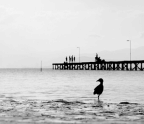Caravan for the Disappeared
 Credit: Consuelo Pagaza
Credit: Consuelo Pagaza Liliam stared out the window of the bus as it rumbled down the highway. She had come to Mexico for three weeks to look for her sister, Jaqueline. Eleven years ago, Jaqueline had tried to immigrate to the United States. She never made it. Like so many Central Americans before and after her, Jaqueline vanished into the desert.
Jaqueline offered a smuggler $6,000 to get to Texas. Her husband had left for America years earlier. Two weeks after her departure, according to an immigrant who traveled alongside her, Jaqueline twisted her ankle while they were crossing the Sonoran Desert. Liliam received a call stating that the group had left her by a road with some water and a few cookies, which seemed like small payment to save their own skins.
Liliam is barely five feet tall, whispers the punchlines of her jokes, and wears wire-rim bifocals that make her look even more demure. But she dusts herself off when accidents occur and prays to God that all will be saved. She became part of an annual caravan run by the Mesoamerican Migrant Movement, which helps people from Nicaragua and the Northern Triangle—Guatemala, Honduras, and El Salvador—search for relatives who have gone missing.
“I pray to God that she went out onto the road and someone found her,” said Liliam. “Her sons asked for her almost every night.”
The Northern Triangle is the epicenter of bloodshed in Latin America. But it’s in Mexico that people who travel undocumented disappear. Since 2014, when the US started to help increase border security along the Mexico-Guatemala border, migrants have gone looking for more remote routes, placing them are at the mercy of roadside criminals and traffickers. Nobody knows how many have gone missing, but according to an informal estimate from shelters, in 2015
You’re reading a preview, subscribe to read more.
Start your free 30 days





